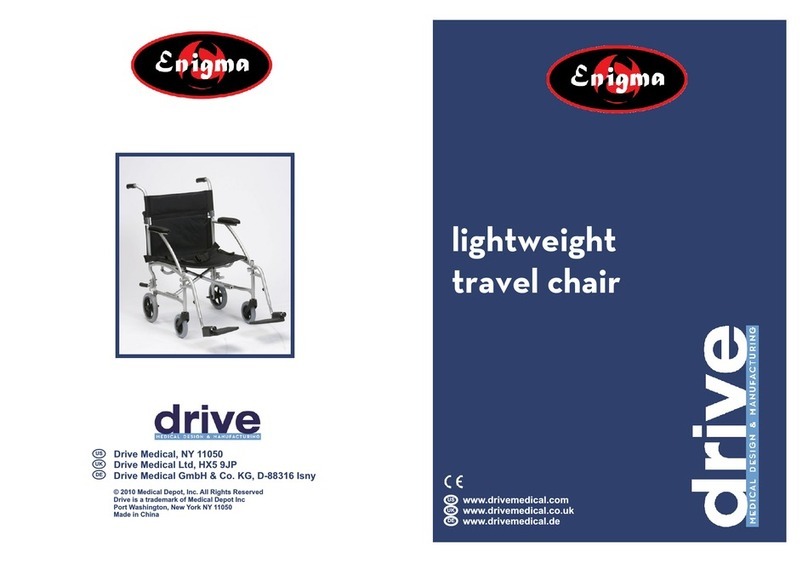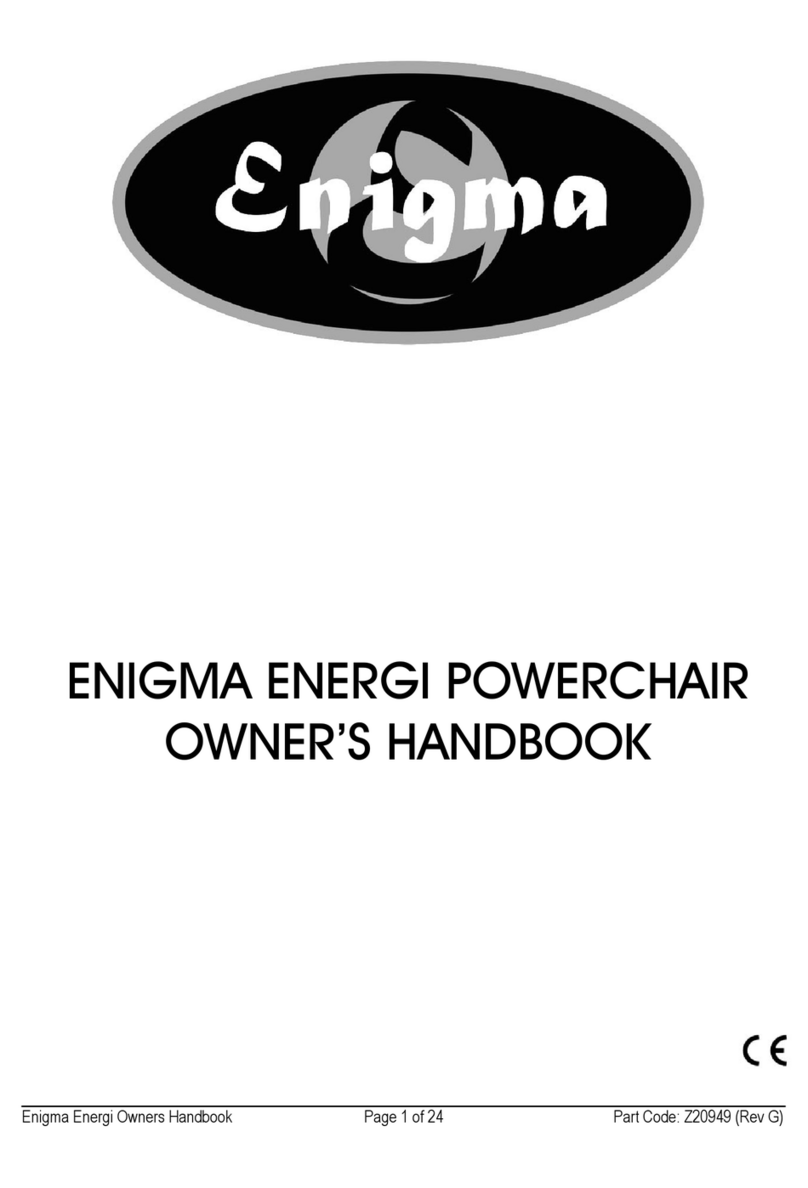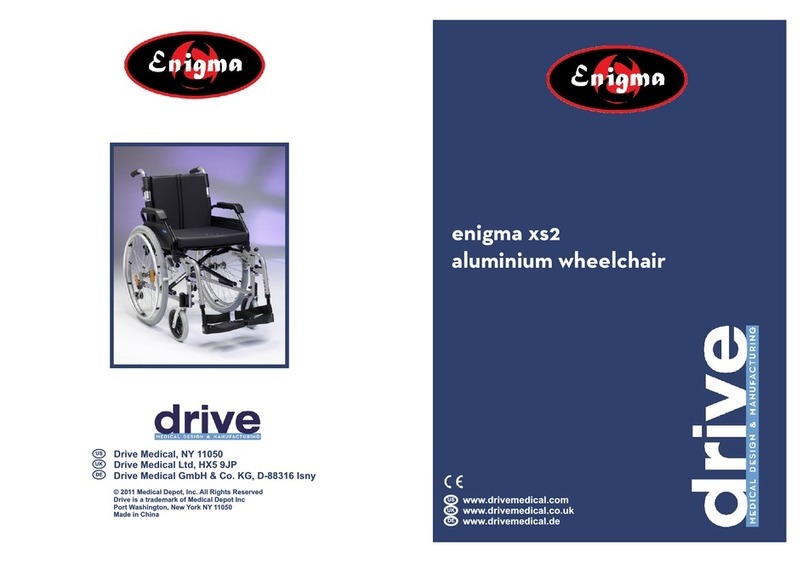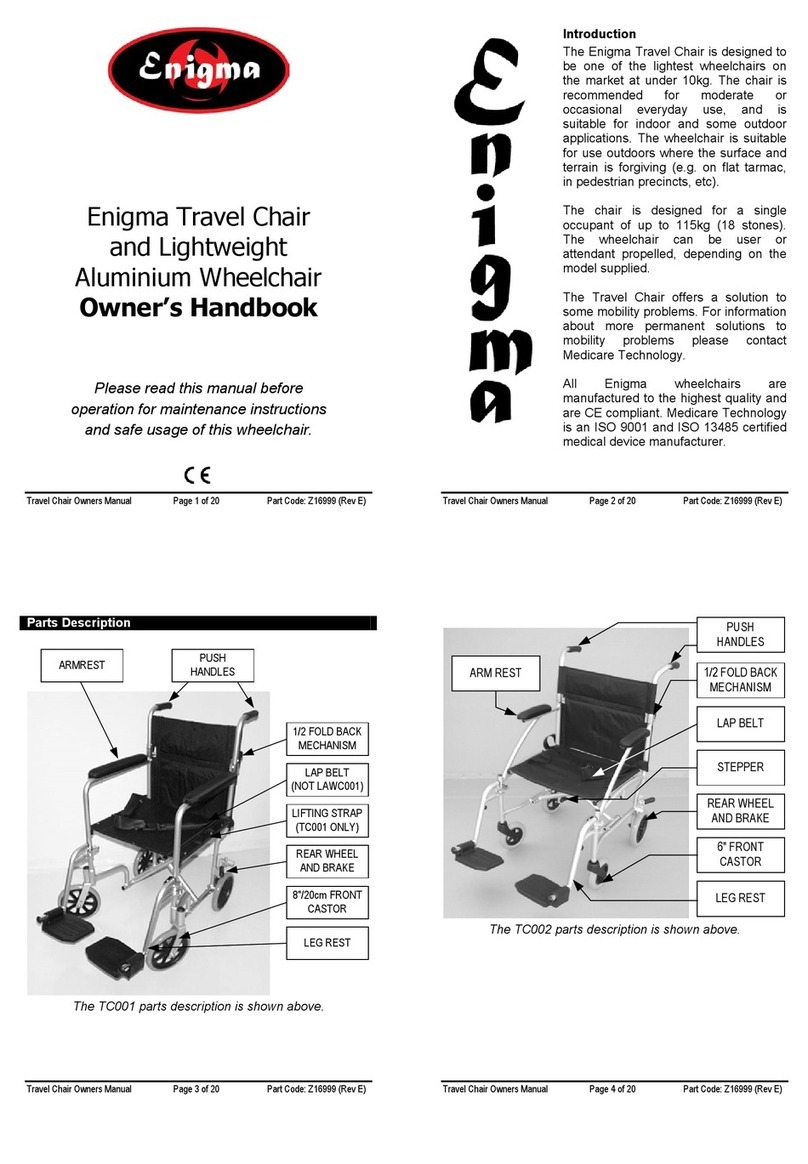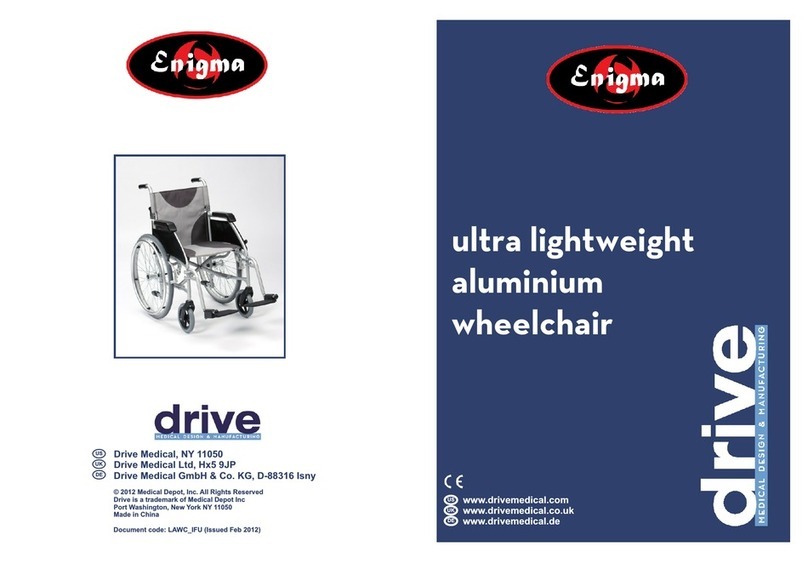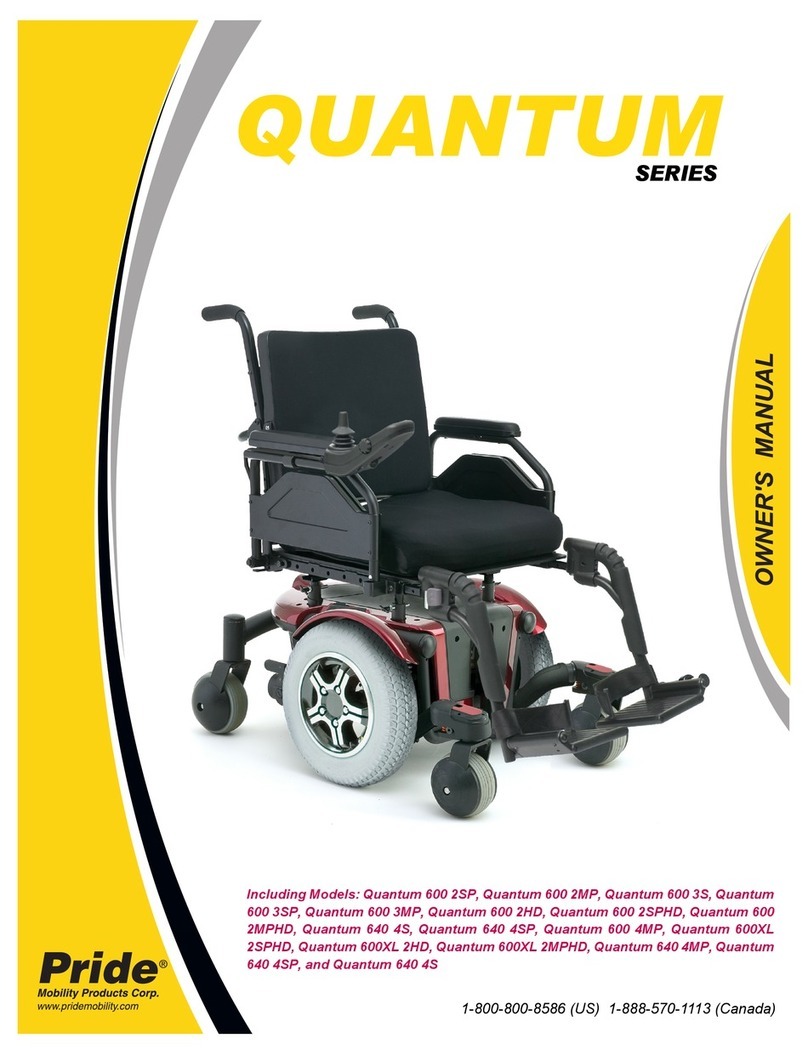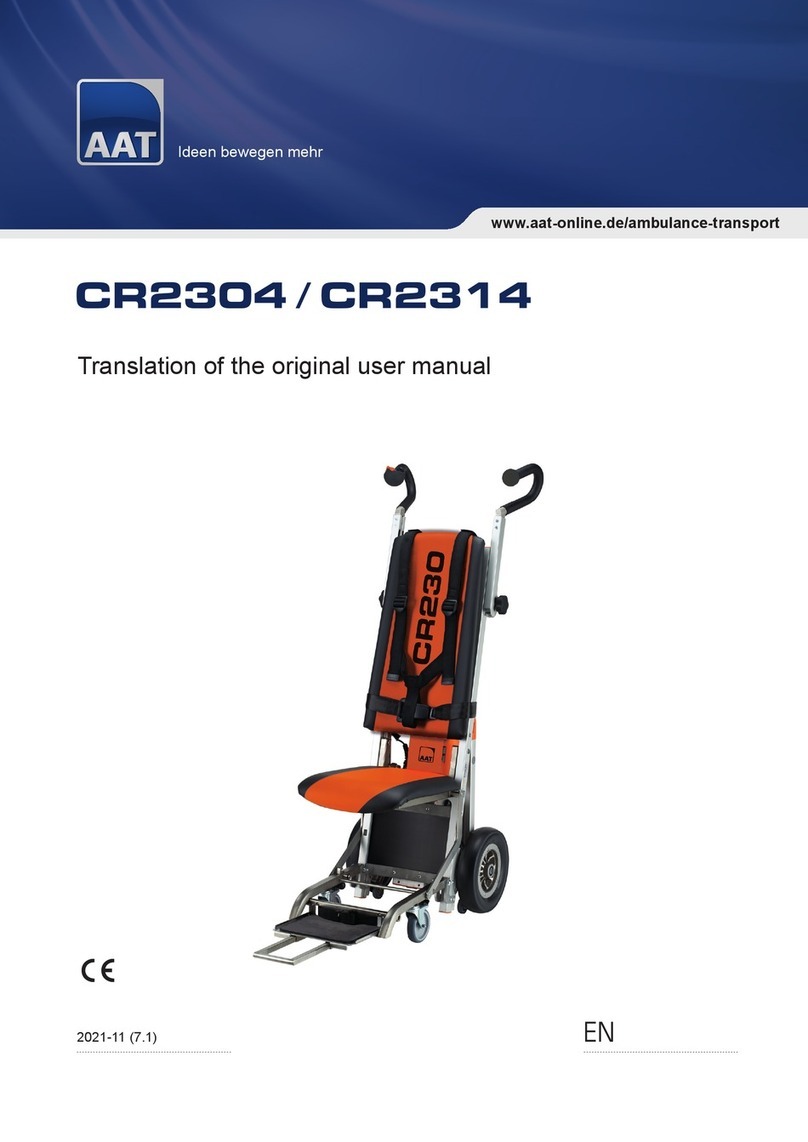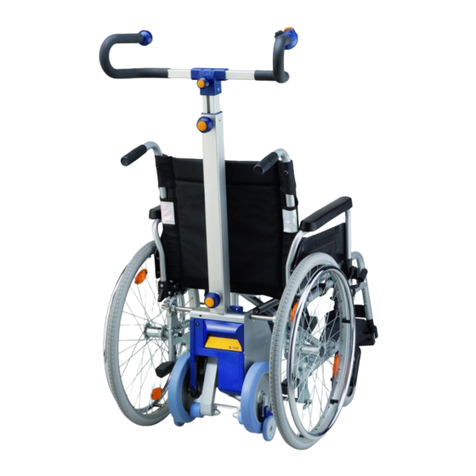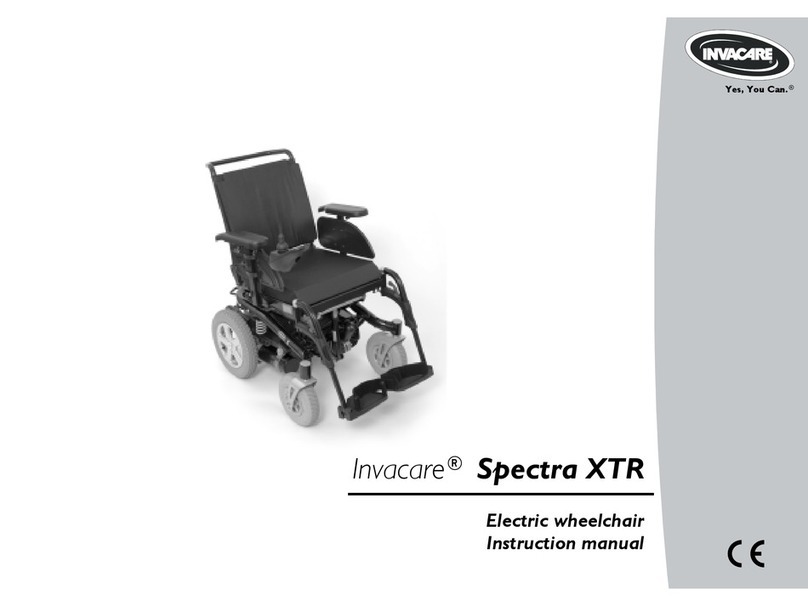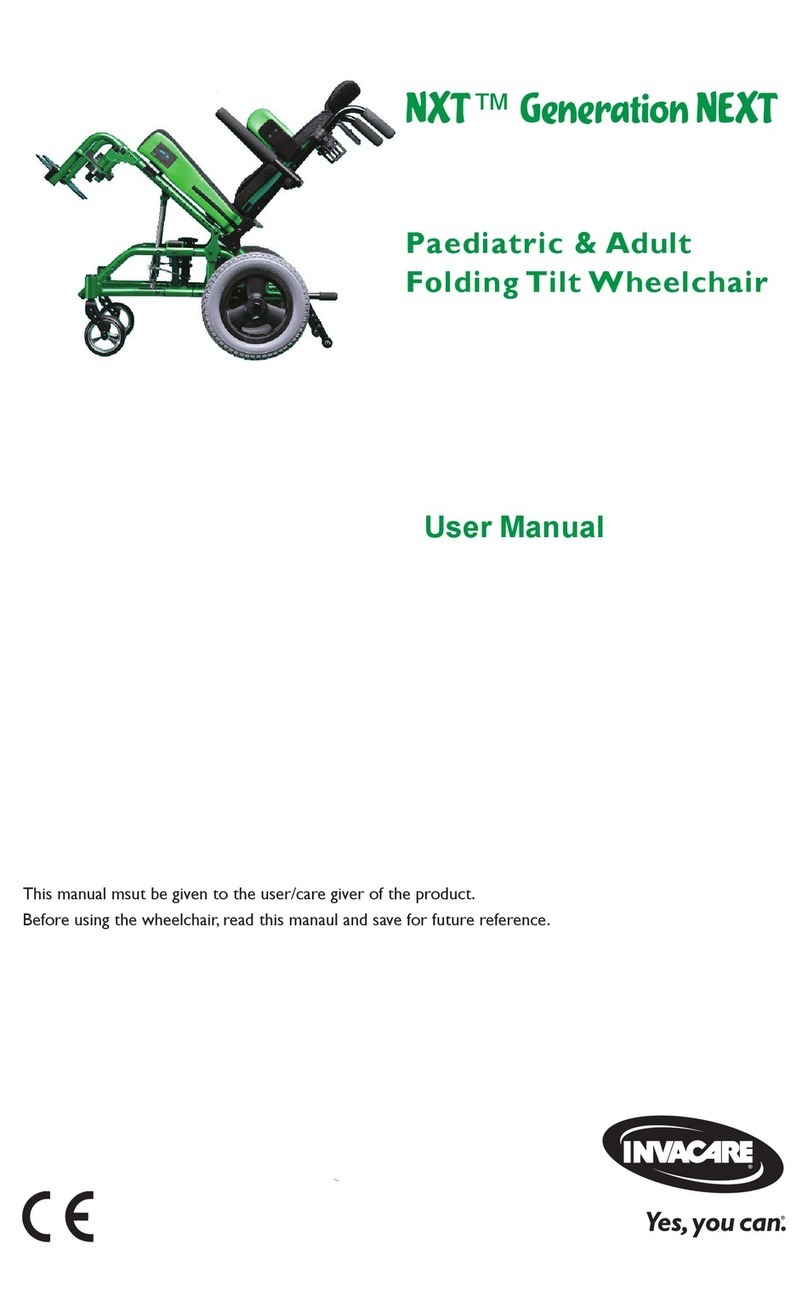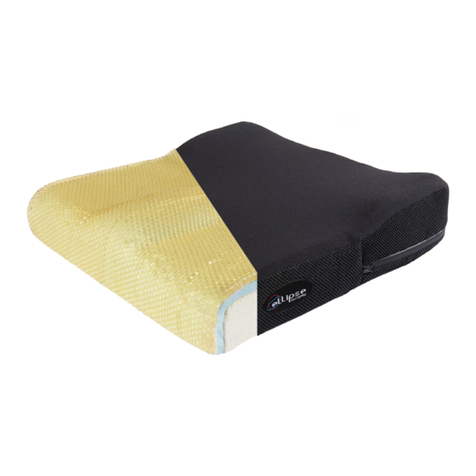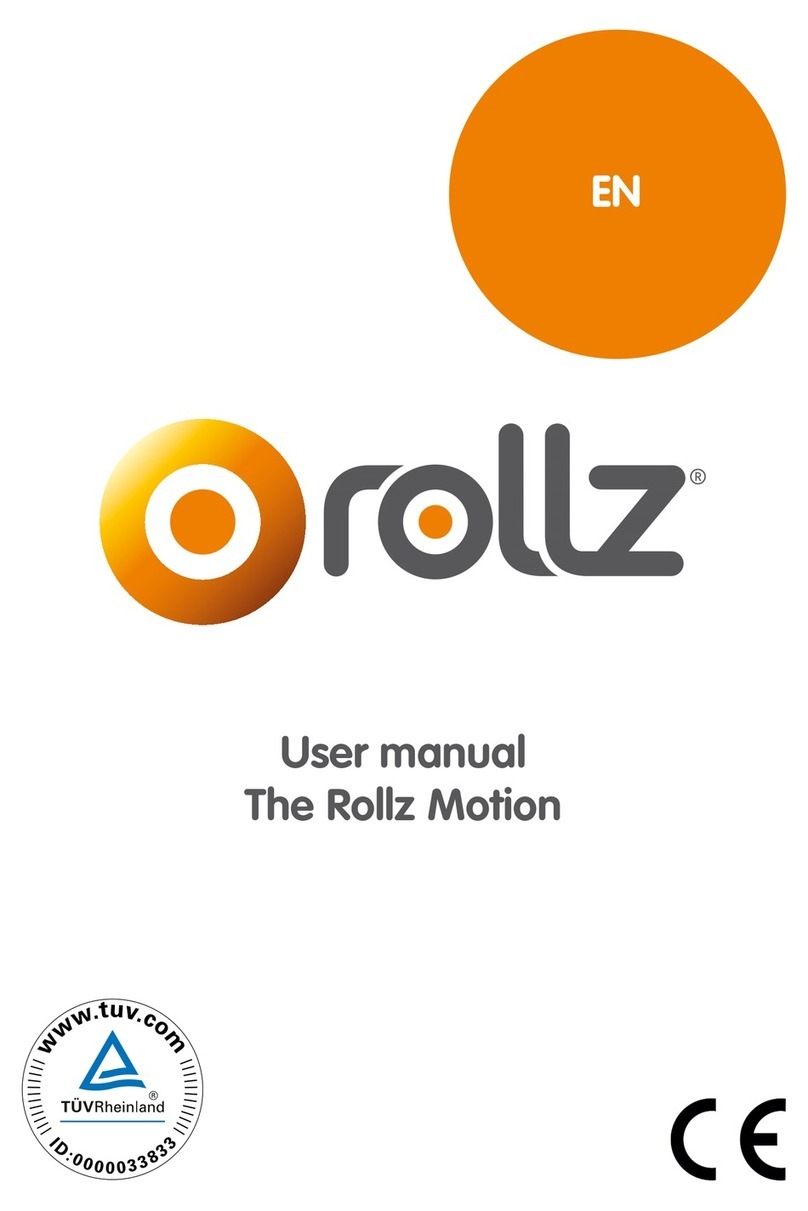Enigma Travel Chair User guide

Owner’s Handbook Page 1 of 12 TC004
Enigma
Travel Chair
Owner’s
Handbook
Please read this manual before
operation for maintenance instructions
and safe usage of this wheelchair.

Owner’s Handbook Page 2 of 12 TC004
Introduction
The Enigma Travel Chair is designed to
be one of the lightest wheelchairs on
the market. The chair is recommended
for moderate or occasional everyday
use, and is suitable for indoor and some
outdoor applications. The wheelchair is
suitable for use outdoors where the
surface and terrain is forgiving (e.g. on
flat tarmac, in pedestrian precincts,
etc).
The chair is designed for a single
occupant of up to 115kg (18 stones), and
is propelled by an attendant using the
push handles.
The Travel Chair offers a solution to
some mobility problems. For
information about more permanent
solutions to mobility problems please
contact Drive Medical.
All Enigma wheelchairs are
manufactured to the highest quality
and are CE compliant. Drive Medical is
an ISO 9001 and ISO 13485 certified
medical device manufacturer.

Owner’s Handbook Page 3 of 12 TC004
Parts Description
PUSH
HANDLE
HALF-FOLD
BACK MECH
ARM
REST
LAP BELT
LIFTING
STRAP
BRAKE
8" (20cm)
WHEEL
FRONT
CASTOR
LEG REST

Owner’s Handbook Page 4 of 12 TC004
1. Contents
1.
Contents
2.
Legrest Adjustment
3.
Folding the Wheelchair
4.
Half-Folding Back Mechanism
5.
Transporting the Wheelchair
6.
Using the Stepper Tube
7.
Using the Lap Belt
8.
Brake Operation
9.
Operation & Propulsion
10.
Care and Maintenance
11.
Specification
12.
Warranty
2. Legrest Adjustment
For optimum comfort it is important to attain the correct
leg position. The footrests have been designed so that they
can be extended into a number of fixed positions by
releasing the bolt at the base of the legrest. This lengthens
the legrest into a number of different positions.
3. Folding the Wheelchair
The Enigma wheelchair has been designed with an easy fold
mechanism. To fold the chair, ensure that the footrests are
in the forward position and that the plastic footplates are
flipped up. Holding the front and rear edge of the seat sling,
pull the seat in an upward motion. The wheelchair will naturally
fold up.

Owner’s Handbook Page 5 of 12 TC004
4. Half-Folding Back Mechanism
The backrest has an in-built
half folding back which has
been designed so that the
wheelchair will fit into small
spaces by reducing the push
handle height. In order to
fold down the backrest,
push the black paddle with
your thumb (see photo left)
whilst pulling the handle
down. This operation should
be repeated for the other
handle.
To put the backrest back
into position, lift both
handles together and the
folding mechanism will lock
back automatically.
Warning:
Do not push down on the
handles to raise the front of
the wheelchair, as this could
result in damage to the
wheelchair. Use the stepper
tube as described in Part 6.

Owner’s Handbook Page 6 of 12 TC004
5. Transporting the Wheelchair
To transport the wheelchair, first fold up the wheelchair
and fold down the back as previously described. Then
remove the legrests by pushing the chrome lever on the
legrests whilst pulling the legrest away from the chair. This
operation should unlock the legrest and allow it to be
removed by lifting up on the legrest.
The Travel Chair comes with an optional easy-to-carry bag.
Put the wheelchair and two legrests in the bag. Ensure that
the latest health and safety practice is used for carrying and
lifting items.
6. Using the Stepper Tube
Use the stepper tube to raise the front castors (when
mounting a kerb for example).
!
Warning:
Do not raise the front castors by pushing down
on the push handles as this could result in
damage to the wheelchair.
To mount a kerb. Approach the kerb head on. Then the
attendant uses the stepper tube to raise the front castors,
and lowers the front castors on the raised kerb. Finally the
attendant should push the wheelchair forward, lifting it up
slightly to mount the kerb if required.

Owner’s Handbook Page 7 of 12 TC004
To go down a kerb. Line up the front castors with the edge
of the kerb. The attendant uses the stepper tube to raise
the front castors and tip the user slightly back. Keeping the
castors raised, slowly lower the wheelchair down the kerb.
!
Warning:
Do not raise the front castors by pushing down
on the push handles as this could result in
damage to the wheelchair.
7. Using the Lap Belt
The lap belt is to restrain the wheelchair occupant during
normal use. The lap belt can not be used as a seat belt in a
motor vehicle. Under no circumstances should the Travel
Chair be used as a seat in a motor vehicle (e.g. cars, buses,
trains, etc).
The lap belt should be adjusted to suit each user. The
length of the belt can be adjusted by the tri-glides (as
shown in the diagram overleaf). The lap belt has a luggage-
style large locking clip to fasten and unfasten the lap belt.
To fasten the lap belt, push the clip in to the receiver until it
locks in the position (which can be heard by an audible
click).
When fastened, the lap belt should be tight around the
user’s pelvis without causing discomfort or undue pressure.
This will help keep the user’s hips and pelvis towards the

Owner’s Handbook Page 8 of 12 TC004
back of the wheelchair. Use the tri-glides (shown) to adjust
the length of the lap belt. The length of the lap belt should
be checked each time the belt is used.
There is a risk of suffocation from users ‘submarining’
(where they slide down the chair until the lap belt is around
the neck area). To reduce the risk of this, ensure that the
lap belt is used under supervision and is used as instructed.
The lap belt may not be suitable for all users of wheelchairs.
Seek professional medical advice before using the lap belt.
8. Brake Adjustment and Operation
To apply the parking brakes, push the plastic brake handle
towards the front of the wheelchair. Push the handle back
to release the brakes. The brakes should be used as parking
brakes when the wheelchair is stationary.
The brakes are preset, and adjustment should
only be necessary if the brakes become loose
or no longer function correctly.

Owner’s Handbook Page 9 of 12 TC004
9. Operation and Propulsion
!
Before Using the Wheelchair read the safety
notices below:
•Use slow speeds on gradients. Do not exceed
the maximum gradient stated.
•The wheelchair is only suitable for single
occupancy.
•Keep your feet on the footplates when moving.
Do not stand on the footplates.
•Do not use escalators.
•Do not reverse down a gradient
•Maintain proper balance at all times. Users
should not move their centre of gravity out of
the seating area.
•Do not reach for items further than your arm
will extend.
•Be aware of hazards in your environment, such
as narrow doorways, steps, household
appliances, children’s toys, etc.
•We recommend you consult your healthcare
professional for advice about transferring to
and from the wheelchair. The parking brakes
should always be applied when transferring.
•The wheelchair brakes are parking brakes and
are not suitable for slowing the wheelchair
down.

Owner’s Handbook Page 10 of 12 TC004
•Propulsion
•The Travel Chair can only be propelled by an attendant
using the push handles
•
10. Care and Maintenance
•Check the brakes before each use of the wheelchair.
•The wheelchair should be stored in a dry environment,
away from direct sunlight. When in storage the
wheelchair can be folded up
•The wheelchair should be kept clean and dust free. This
can be done with a duster or damp cloth.
•The user should routinely check the following items. It is
recommended that a Drive Medical dealer services the
wheelchair annually, where these items should be
repaired, replaced, adjusted and/or lubricated if
required:
•Tyre wear
•Wheel bearings
•Castors
•Brakes
•Legrest lock
•
Seat & Back upholstery
•Arm pads
•Half folding back mechanism
•Back posts
•Wheelchair (folds up)

Owner’s Handbook Page 11 of 12 TC004
11. Specification
Code SL6101-08
Dims *1 (LxWxH) 90 x 60 x 100cm / 35½” x 23½” x 39½”
Dims *2 (LxWxH) 67 x 27 x 81cm / 26½” x 10½” x 32”
Seat (LxWxH) 40 x 48 x 50cm / 16” x 19” x 20”
Total Weight 11.1kg (24.4lb)
Max User Mass (weight capacity) : 115kg / 18 stone
Maximum Gradient: 10º
All dimensions are based on the wheelchair in its default configuration.
Dimensions * 1 refers the wheelchair assembled
Dimensions *2 refers to the wheelchair folded and parts removed
!
Warning: Do not exceed the weight capacity or
gradient stated above. Failure to do so could
result in damage or injury.
Manufactured by:
Drive Medical Ltd,
Ainley’s Industrial Estate, Elland,
West Yorkshire, GB HX5 9JP.
+44 (0) 1422 314488
enquiries@drivemedical.co.uk
www.drivemedical.co.uk

Owner’s Handbook Page 12 of 12 TC004
12. Warranty
There is a comprehensive twelve-month warranty from the date on which your new
wheelchair is delivered. The warranty covers the wheelchair for replacement parts
during this period. For more detail, please see the warranty conditions overleaf:
1. Any work or replacement part installation must be carried out by an authorised
Drive Medical dealer / service agent.
2. To apply the warranty should your wheelchair require attention please contact
the outlet from which you purchased the wheelchair.
3. Should any part of the wheelchair require repair or full or part replacement, as a
result of a manufacturing or material defect within the warranty period, parts will
be supplied free of charge. Note: The guarantee is not transferable.
4. Any repaired or replaced parts will be covered by the balance of the warranty
period on the wheelchair.
5. Parts replaced after the original warranty has expired will be covered by a three-
month warranty.
6. Consumable items supplied will not generally be covered during the normal
warranty period unless such items require repair or replacement clearly as a
direct result of a manufacturing or material defect. Such items include (among
others): upholstery and tyres.
7. The above warranty conditions apply to brand new wheelchairs. Ex-demonstration
wheelchairs supplied directly by Drive Medical carry a six-month warranty period.
If you are unsure whether your wheelchair is covered contact your dealer.
8. Under normal circumstances, no responsibility will be accepted where the
wheelchair has required assistance as a direct result of:
a. the wheelchair part not having been maintained in accordance with the
manufacturers recommendations
b. failure to use the manufacturer’s specified parts
c. the wheelchair or part having been damaged due to neglect, accident or
improper use
d. the wheelchair or part having been altered from the manufacturer’s
specification or repairs having been attempted before the dealer is notified
In the event of your wheelchair requiring attention, please contact your service agent /
dealer and give all relevant details so they can act quickly.
The manufacturer reserves the right to alter without notice any weights, measurements
or other technical data shown in this manual. All figures, measurements and capacities
shown in this manual are approximate and do not constitute specifications.

Owner’s Handbook Page 13 of 12 TC004
Table of contents
Other Enigma Wheelchair manuals

